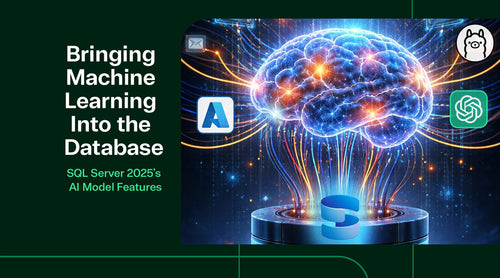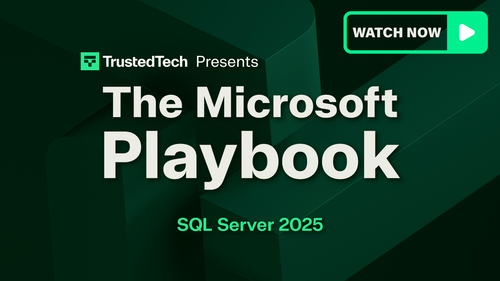Microsoft SQL Server 2025 marks one of the most significant leaps forward in the database's history, infusing advanced AI capabilities directly into the core of the platform. This release introduces new tools and features across five key areas: Developer Tools, Machine Learning & AI Model Management, Analytics & Search, Data Management, and Security, all designed to empower IT professionals while remaining accessible to a broader audience.
In plain terms: SQL Server 2025 transforms the traditional database into an "AI-ready" data platform, enabling natural language interactions, machine learning, semantic search, streamlined data integration, and stronger security. Let's break down the most essential AI integrations in SQL Server 2025, why they matter, and how you can use them, and compare how these key areas have evolved since SQL Server 2022.
SQL Server 2025 vs 2022: AI Feature Improvements at a Glance
Major differences between SQL Server 2022 and 2025 in key areas. SQL 2022 laid the groundwork with cloud connectivity and performance improvements, but SQL 2025 introduces transformative AI integration, developer-friendly features, and security enhancements that make it a more intelligent and future-proof data platform.
| Feature Area | SQL Server 2022 | SQL Server 2025 |
|---|---|---|
| Developer Tools | Traditional query editing with no AI assistance. No built-in tool to convert natural language to SQL. JSON handled as text (no native JSON type), and no regex functions in T-SQL. |
Copilot integration in SSMS and VS Code enables natural language query writing and optimization. Supports LangChain/Semantic Kernel for in-database AI apps. Adds native JSON type with indexing and regex in T-SQL for advanced text and data handling. |
| ML & AI Model Integration | No in-engine machine learning or AI features. Relied on external ML services or the older Machine Learning Services (R/Python) for any in-database ML, which were separate and not integrated with T-SQL workflow. No vector data type or semantic search, only basic full-text search. |
Built-in AI support, including a native VECTOR data type with DiskANN indexing for similarity search, and the ability to register and invoke external AI models via T-SQL (calls to Azure OpenAI, etc.). Enables in-database ML/AI: you can score models or do NLP directly in queries. In short, the database itself can now handle embeddings, LLMs, and more, without external orchestration. Also introduces AI-assisted T-SQL features like natural language to SQL conversion through integrated services. |
| Analytics & Search | Relational and full-text search only, queries had to match text or use LIKE patterns. No concept of vector similarity search or understanding of query intent (semantically related terms). Real-time analytics were limited, SQL 2022 offered Azure Synapse Link (near-real-time replication for analytics) but no native event streaming; Change Data Capture existed but required custom solutions to stream events. |
Semantic search and AI-driven analytics – supports vector similarity searches natively (finds results by meaning, not just exact text). Can integrate with AI to answer natural language questions on the data. Also integrates with Microsoft Fabric for analytics; you get zero-ETL, near-immediate data replication to lakes/warehouses for BI and AI consumption. This makes real-time dashboards and AI triggers feasible, where 2022 had latency. |
| Data Management | Rigid schema or clunky handling of semi-structured data. JSON was stored as text and parsed via functions (slower). No vector type (embeddings often stored externally or as blobs). No regex, meaning complex string filtering required workarounds or CLR. Integration with analytics required ETL or Synapse Link (batchy). Developers couldn’t easily call REST APIs from SQL (needed external app or CLR proxy). |
Flexible, modern data support – Native JSON type with indexing for faster queries on JSON documents. VECTOR type for embeddings, treating ML data as first-class. Regex functions like REGEXP_LIKE built-in for advanced string queries. Also adds ability to call external REST endpoints from T-SQL (via sp_invoke_external_rest_endpoint), expanding data integration capabilities. Fabric Zero-ETL mirroring means operational data can be seamlessly synced to cloud analytics platforms in near real time. Overall, 2025 handles variety and volume with ease, storing and processing new data types internally rather than via external hacks. |
| Security & Compliance | Supported Azure AD authentication for connecting clients and had features like Ledger for tamper-evident tables. However, still heavily used service accounts and secrets for connecting to other services; no managed identity for on-prem SQL. Default encryption methods and password hashing were older (SHA-1/2, PBKDF2 with fewer iterations). Role-based security was strong for DB access, but new AI/ML features weren’t in scope (since they didn’t exist). |
Identity-driven, secure by default – Introduces Managed Identities (Entra ID) for SQL Server to use with Azure services, eliminating the need for storing credentials when, say, backing up to cloud or calling an API. Implements a Zero Trust approach: all access is authenticated and minimal, with TLS 1.3 encryption by default in many cases. Stronger cryptography: uses AES-256 with secure padding for encryption and PBKDF2 (100,000 iterations) for password hashing, improving resistance to attacks. Role-Based Access Control now extends to AI functions e.g., who can create or execute external model calls, with full auditing. Continues tamper-evidence via Ledger with performance improvements. Net effect: 2025 reduces secret sprawl and boosts compliance alignment while embracing new features. |
SQL Server 2025 AI Frequently Asked Questions
A: SQL Server 2025 introduces AI integration with native vector data types, vector indexing, and support for external AI models. It also includes Copilot in SSMS for natural language query assistance, regex functions in T-SQL, and a native JSON data type with indexing.
A: Yes, upgrades are supported starting with Release Candidate 0 (RC0). Make sure your system meets the updated hardware and OS requirements.
A: SQL Server 2025 runs on Windows and Linux. Linux support now includes TLS 1.3 and Ubuntu 24.04.
A: It’s a database-scoped configuration that lets you opt into experimental features like vector search, external models, and change event streaming.
A: Encryption is now mandatory for SQL Server Agent, linked servers, replication, and log shipping. TLS 1.3 and TDS 8.0 are also supported.
A: Yes, Developer editions for both Standard and Enterprise are available for free, with full feature parity for development and testing.
A: Enhancements include asynchronous page request handling, configurable commit wait times, and improved distributed availability group synchronization.
A: DiskANN (Disk Accelerated Approximate Nearest Neighbors) is a vector indexing algorithm that allows scalable, disk-based indexing for high-dimensional data, improving performance and relevancy in AI applications.
A: Yes, SQL Server 2025 supports local hosting of AI models, enabling secure and customizable AI integration without relying on cloud-based services.
A: Features like Arc Agent and Entra ID authentication allow SQL Server to operate seamlessly across cloud and on-premises environments, supporting integrated data estates.
A: Enhancements include better JSON indexing, regex support, and change event streaming, making it easier to build responsive and modern applications.
Shop our SQL Server Products
 |
When Should You Upgrade?
|
Resources
Microsoft SQL Server Blog – “Announcing SQL Server 2025 (Preview): The AI-ready enterprise database from ground to cloud” (May 2025)
Microsoft Learn – “What’s New in SQL Server 2025 (Preview)” (Official Documentation, Aug 2025)
ChampSoft Blog – “Why SQL Server 2025 Is the Future of AI-Powered Databases” (July 2025)
MSSQLTips – “SQL Server 2025 New Features” by Rajendra Gupta (July 2025)















